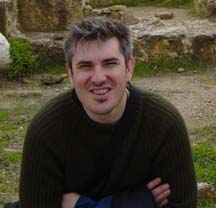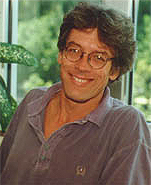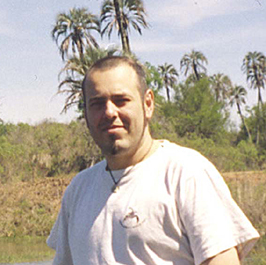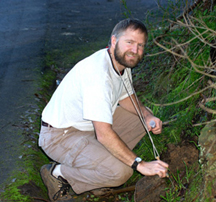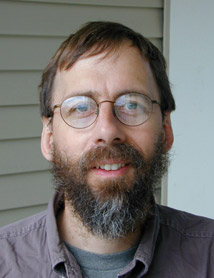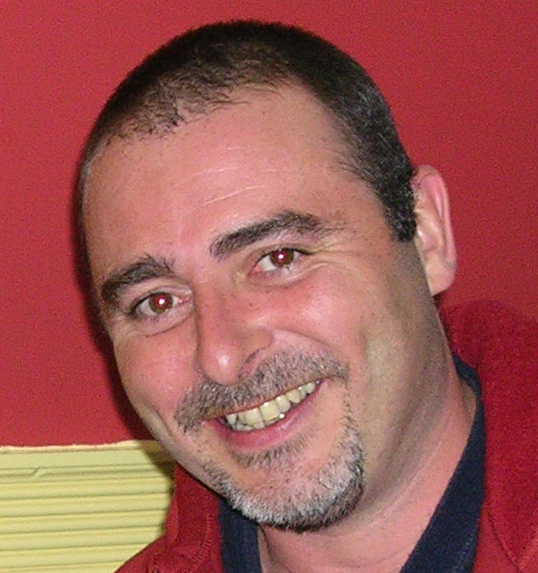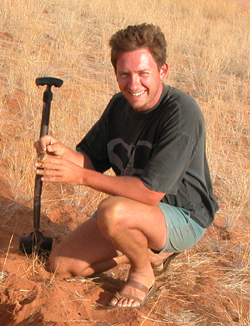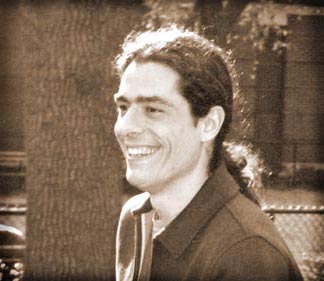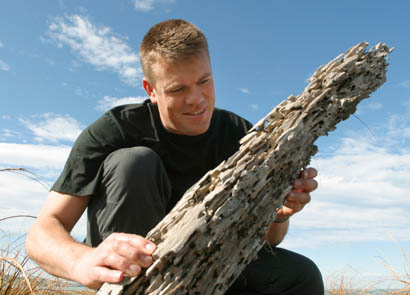| Participants
Contributions to Assembling Tree of Life: Phylogeny of Spiders My involvement in the ATOL: phylogeny of spiders project is two fold. Firstly, I am the Clademaster (i.e. responsible for making specimens for the selected taxa available for the study and for getting them scored in the morphological data matrix) of several haplogyne families, namely the Dysderids, Segestrids, Oonopids, Orsolobids, Leptonetids, Ochyroceratids and Pholcids. Secondly, I am leading the generation of Expressed Sequence Tags (EST's) from newly constructed cDNA libraries of a selected list of spider taxa, with the aim to develop new molecular markers for inferring spider phylogenies at the family level. Research Interests My research focuses firstlly on the study of speciation and biodiversity and secondlly on the study of evolution of behavior in a phylogenectic frame work.
Contributions to Assembling Tree of Life: Phylogeny of Spiders I work with Gustavo Hormiga as a postdoctoral fellow. My responsibilities include imaging specimens using light and scanning electron microscopy, and scoring morphological characters for exemplar taxa of the families Amaurobiidae, Dictynidae, Hahniidae, Linyphiidae, Pimoidae, Tetragnathidae, Mysmenidae and Synaphridae. Research Interests My research interest focuses on understanding factors that form and maintain biodiversity. They include for example, the processes that lead to adaptive radiations or the study of the role of behavior in speciation. I use behavior, morphology and molecular data to address these questions and use my favorite animals, spider as models in my studies. A large part of my current research focuses on the evolution of web construction behavior in theridiids and linyphiids. These spiders are related to spider that construct orb-webs, however they appear to have either lost or modified their behavior to come up with a wide range of web designs.
Contributions to Assembling Tree of Life: Phylogeny of Spiders I am clademaster for all Mesothelae (family Liphistiidae) and Mygalomorphae (families Actinopodidae, Atypidae, Antrodiaetidae, Barychelidae, Ctenizidae, Cyrtaucheniidae, Dipluridae, Hexathelidae, Idiopidae, Mecicobothriidae, Microstigmatidae, Migidae, Nemesiidae, Paratropididae, and Theraphosidae). Research Interests The primary focus of the work in my laboratory is the study of arthropod diversity. Arachnids and myriapods are the main study organisms I utilize with a particular emphasis on spiders of the infraorder Mygalmorphae (trapdoor spiders, tarantulas, & their relatives) and millipedes of the order Spirobolida. Although millipedes and trapdoor spiders are nontraditional evolutionary models they are ideal candidates for evolutionary studies because of their limited dispersal capabilities and thus tendency to become easily, and apparently quickly, isolated. My work on spiders and millipedes spans a number of hierarchical levels; in addition to being interested in higher level classification issues in spiders and millipedes I am also interested in alpha taxonomy, and use the insights gained in this most basic, yet important work, to consider questions about speciation process. Because evolutionary diversification is a complex, multifaceted process, the study of it, at all levels, requires an integrated phylogenetic approach. By using the insights gained through comparative morphology, molecular evolution, biogeography, ecology, and morphometrics, within the context of an explicit phylogenetic framework, I attempt to address questions regarding the pattern and process of diversification in these very interesting groups of organisms.
Contributions to Assembling Tree of Life: Phylogeny of Spiders I am clademaster for the orbicularian families Deinopidae, Uloboridae, Theridiosomatidae, and Theridiidae. Research Interests My research spans three broad topics: the systematics and evolution of spiders, especially orbweavers; issues in systematic theory and method; and, most recently, the theory and design of biological inventories. Research on spider systematics has been directed at producing and synthesizing a first estimate of the higher phylogeny of spiders (e.g. "families"), especially orb-weaving spiders and their relatives. The resulting cladograms have been applied to empirical and theoretical studies of adaptation, behavior, evolution of web architecture, silk glands and spinneret spigot morphology, male genitalia, sexual size dimorphism, and patterns of species richness in spiders. I am interested in how adaptational hypotheses are developed and tested, as well as criteria for cladistic support. Finally, as a museum scientist, it seems appropriate to focus on design and evaluation of rapid, efficient, quantitative sampling protocols to better understand the structure and distribution of biodiversity.
Contributions to Assembling Tree of Life: Phylogeny of Spiders I am responsible for improving algorithms/programs for analysis of large data sets. Research Interests Spider biology and systematics; quantitative cladistic theory.
Contributions to Assembling Tree of Life: Phylogeny of Spiders I am Martín Ramírez’s assistant in his work on the Atlas for the ATOL project, and acquiring data on the families where he is clademaster, doing curation and identification of specimens, preparations, illustrations and other technical-scientific tasks. I also conducted several field trips in Argentina for collecting ATOL specimens. Research Interests Morphology, taxonomy, faunistics and diversity of spiders, especially the families Palpimanidae, Filistatidae, Uloboridae, Zodariidae and Segestriidae.
Contributions to Assembling Tree of Life: Phylogeny of Spiders I am clademaster for the following families: Agelenidae, Amphinectidae, Chummidae, Ctenidae, Cyatholipidae, Cybaeidae, Cycloctenidae, Desidae, Halidae, Neolanidae, Phyxelididae, Stiphidiidae, Synotaxidae, Titanoecidae, Zorocratidae, and Zoropsidae. Research Interests I am interested in the higher classification of spiders; biogeography of the afromontane region and the southern continents; biotic surveys of Madagascar and the Indo-Burman region of SW China and Myanmar.
Contributions to Assembling Tree of Life: Phylogeny of Spiders I am helping to develop new genes for deep spider phylogenetics. I am also clademaster for the families Homalonychidae and Nesticidae. Research Interests Spider diversity and evolution, speciation, phylogenetics, biogeography, cave biology.
Contributions to Assembling Tree of Life: Phylogeny of Spiders I am clademaster for the families Amaurobiidae,
Dictynidae, Hahniidae, Linyphiidae, Pimoidae, Tetragnathidae, Mysmenidae
and Synaphridae. Research in my laboratory focuses on the systematics and evolutionary biology of spiders, with emphasis on orbweavers and their close relatives (Araneoidea). Our systematic work addresses mainly three spider lineages, the sheet weaving families Linyphiidae and Pimoidae and the orb weaving families Tetragnathidae and Mysmenidae. Our research focuses both on phylogenetics reconstruction and taxonomic work. We use morphological, molecular and behavioral characters to reconstruct the phylogenetic relationships of our study organisms, to tackle questions that span from species level problems to interrelationships of families. Our work highlights the importance of reconstructing the history of evolutionary changes for addressing comparative questions, such as the evolutionary patterns of sexual size dimorphism in orbweavers or the patterns of diversification and biogeography in the Hawaiian archipelago.
Contributions to Assembling Tree of Life: Phylogeny of Spiders I am clademaster for the family Salticidae. Research Interests My research arose from a fascination with the diversity of forms and behaviours of jumping spiders, which led to systematics, which led to phylogenetic theory and computer programming. My work continues to be both empirical, on spiders, and theoretical, on the use of phylogeny in evolutionary inference.
Contributions to Assembling Tree of Life: Phylogeny of Spiders I work with Jonathan Coddington as a postdoctoral fellow. My responsibilities include compiling legacy data from all previous higher-level phylogenetic studies of spiders, imaging specimens using light and scanning electron microscopy, and scoring morphological characters for exemplar taxa of the families Uloboridae, Deinopidae, Theridiosomatidae, and Theridiidae. Research Interests My dissertation research was concerned with the systematics of the linyphiid spider subfamily Erigoninae in the Neotropics. I am currently developing a new research program on the evolution of widow spiders (Theridiidae: Latrodectus). I am also interested in quantitative biodiversity inventory studies and ectoparasites of bats.
Contributions to Assembling Tree of Life: Phylogeny of Spiders I am responsible for the spider palaeontological data. Research Interests My current research on fossil spiders includes: taxonomy; evolutionary history of the Araneae, the qualitative and quantitative use of palaeontological data in testing hypotheses of palaeoecology and palaeogeography, the effects of mass extinctions on spiders, and predator-prey co-evolutionary processes. I am also particularly interested in examining the biases of amber preservation, comparing different ambers and their inclusions, the palaeogeographic origins and current biodiversity of the Greater Antillean spider fauna and the completeness versus the adequacy of the spider fossil record.
Contributions to Assembling Tree of Life: Phylogeny of Spiders I am responsible for the collection and analysis of data for the outgroup taxa: Amblypygi, Uropygi, Schizomida, and Palpigradi. I also coordinate the flow of tissue samples for DNA isolation to the Molecular Systematics Laboratory at AMNH. Research Interests My primary research interests lie in
the empirical study of phylogeny, macroevolution, speciation, biogeography,
and comparative evolutionary biology, using scorpions and minor arachnid
orders (Amblypygi, Uropygi, Solifugae and Schizomida) as model organisms.
One of my current research projects is a global phylogeny of the Scorpiones,
using morphology and DNA. Besides investigating phylogenetic relationships
among the major lineages of these taxa, I have specific interests in
revisionary systematics, particularly of the Afrotropical scorpion
Contributions to Assembling Tree of Life: Phylogeny of Spiders I am the Atlas master for the ATOL project, which is the organization of all the morphological data in a coherent system. I am coordinating together with Jeremy Miller the review process of the phylogenetically informative characters from the legacy data and from our ongoing related projects. I am clademaster for the following families: Anapidae, Anyphaenidae, Austrochilidae, Clubionidae, Cryptothelidae, Filistatidae, Gradungulidae, Hypochilidae, Liocranidae, Miturgidae, Philodromidae, Selenopidae, Sparassidae, Symphytognathidae, Telemidae, Tetrablemmidae, Thomisidae, Zodariidae, and Zoridae. Research Interests Theory of phylogenetic systematics in general. Morphology, phylogeny and diversity of spiders. Alpha taxonomy of South American Amaurobioidinae (Anyphaenidae) and Filistatidae. Higher level systematics of araneomorph spiders, currently focused in dionychan families (including the families Salticidae, Thomisidae, Philodromidae, Corinnidae, Liocranidae, Miturgidae, Clubionidae, Anyphaenidae, Gnaphosoidea, Sparassidae, Selenopidae).
Contributions to Assembling Tree of Life: Phylogeny of Spiders I am a collaborator, with morphological expertise, and clademaster for the families Araneidae, Mimetidae, Nicodamidae and Malkaridae. Research Interests Phylogeny and comparative morphology of
spiders in general. Phylogeny and taxonomy of the spider superfamily
Orbicularia in particular. Biogeography of the spider fauna of the Southern
Hemisphere, and in
Contributions to Assembling Tree of Life: Phylogeny of Spiders I am clademaster for the following families: Lycosidae, Oxyopidae, Pisauridae, Psechridae, Senoculidae, Tengellidae, and Trechaleidae.
Contributions to Assembling Tree of Life: Phylogeny of Spiders I am developing new molecular markers for inferring deep phylogenetic relationships in the Araneae. Research Interests My primary research interest is the systematics and taxonomy of spiders (especially Lycosidae and the New Zealand and Australian fauna) using both molecular and morphological techniques. I have also conducted research in spider ecology (especially in agroecosystems) and the molecular biology and systematics of Microctonus spp. (Hymenoptera).
Contributions to Assembling Tree of Life: Phylogeny of Spiders I am the lead principal investigator on the project and coordinate the acquisition and analysis of molecular data for the project at the American Museum of Natural History.
|
